We've long been fans of the Dot Hill arrays, looking at a few over the years including the AssuredSAN 4824 and the AssuredSAN Ultra48 in both HDD and hybrid configurations. In fact, the Ultra48 never made its way home; it's been in our lab serving as a primary capacity array for some time now. Dot Hill was good about continuing to add features to their controllers, making them some of the best in midrange storage. After the Seagate purchase of Dot Hill mid last year (podcast on the topic), the updates have continued flowing; at the end of last year Seagate pushed out a release that dramatically improved the performance of the 6004 series controllers, amongst several other material updates. This got us to thinking about how much more performance could be squeezed out of the Ultra48 with a relatively simple controller swap. Given Seagate's interest in delivering a fully vertically integrated storage array, the timing seemed right to give it a try.
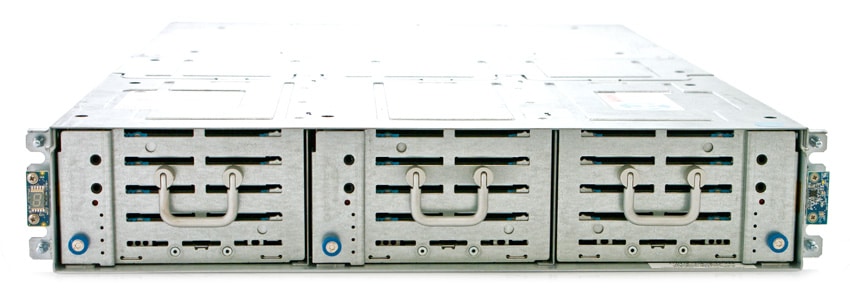
AssuredSAN 6004 Features
- Supported in Ultra48 and Ultra56 platforms
- External Ports: 4 per controller/8 maximum
- Fibre Channel: 16Gb Fibre Channel SFP+
- iSCSI Models: 10Gb NIC or 10Gb iSCSI SFP+
- SAS: 12Gb SAS 2.0 (Serial-attached SCSI) Mini-SAS (8643/8644
- Drive Support: SAS, Nearline SAS, SSD Self encrypting drives
- Expansion: J6X48, J6X56 Supports up to 248 drives in expansion units
- HA Features
- Redundant Hot-Swap Controllers
- Redundant Hot-Swap Disk, Fans, Power
- Dual Power Cords
- Hot Standby Spare
- Automatic Failover
- Multi-Path Support
- Support
- Software Warranty: 30 days
- Standard Hardware Warranty: 3 years
- RAID Levels Supported: 0, 1, 3, 5, 6, 10 and 50
- System Configuration
- Cache Memory: 20GB per 6004 controller
- Volumes per System: 1024
- Mirrored Cache
- Supercapacitor Cache
- Backup Cache Backup to Flash
- Management
- Interface Types: 10/100/1000 Ethernet, Mini USB
- Protocols Supported: SNMP, SSL, SSH, SMTP, SMI-S Provider, HTTP(S)
- Management Consoles: Web GUI, CLI
- Management Software: RealStor Storage Management Console
- Remote Diagnostics
- Non-disruptive Updates
- Volume Expansion
Performance Testing
Dell PowerEdge R730 Virtualized MySQL 4 Node Cluster
- Eight Intel E5-2690 v3 CPUs for 249GHz in cluster (Two per node, 2.6GHz, 12-cores, 30MB Cache)
- 1TB RAM (256GB per node, 16GB x 16 DDR4, 128GB per CPU)
- 4 x Mellanox ConnectX-3 InfiniBand Adapter (vSwitch for vMotion and VM network)
- 4 x Emulex 16GB dual-port FC HBA
- 4 x Emulex 10GbE dual-port NIC
- VMware ESXi vSphere 6.0 / Enterprise Plus 8-CPU
- 10GbE Switching Hardware
- Front-End Ports: Mellanox SX1036 10/40GbE Switch
- 16Gb FC Fabric
- Back-end Ports: Brocade 6510 16Gb Switch
Sysbench Performance
With the previous Dot Hill Ultra48 review narrowing in on a mix of 8 SSDs for a flash tier, with 40 HDDs running as capacity, we leveraged that scheme in our most recent review. The main difference this time around, though, was reaching out to the Seagate SSD team to use the new Seagate 1200.2 1.6TB SAS3 SSDs. Since DotHill operates on a tiered architecture (as opposed to one involving caching), we cut to the chase with using the SSDs only in our storage pools. We used 4 1.6TB SSDs per controller, offering 6.4TB of RAID1 capacity total, equally split between both controllers. For ease of side-to-side comparison, we used the Ultra48 chassis with the 6004-series controllers and the 4824 (24-bay) chassis with the 4004-series controllers.
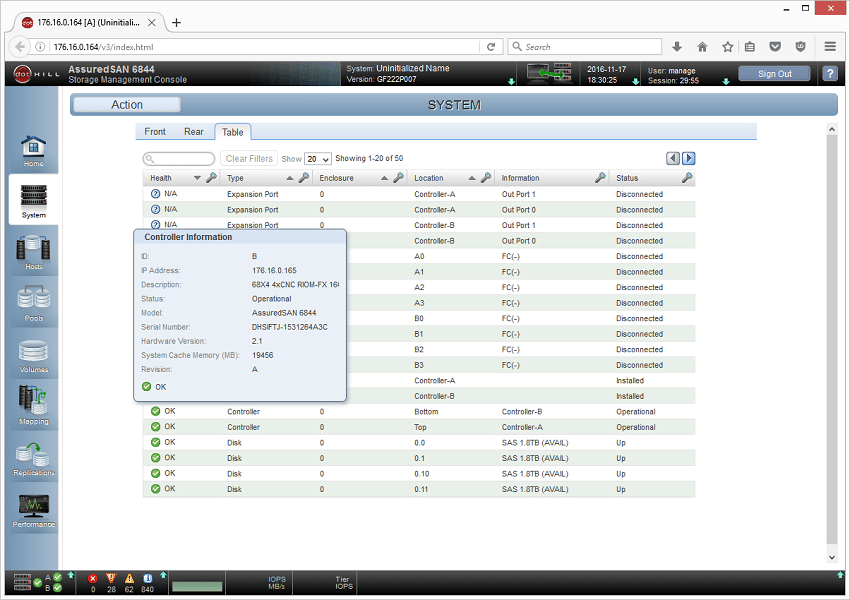
Each Sysbench VM is configured with three vDisks, one for boot (~92GB), one with the pre-built database (~447GB), and the third for the database under test (270GB). In previous tests we allocated 400GB to the database volume (253GB database size), although to pack additional VMs onto the VxRack Node we shrunk that allocation down to make more room. From a system resource perspective, we configured each VM with 16 vCPUs, 60GB of DRAM and leveraged the LSI Logic SAS SCSI controller. Load gen systems are Dell R730 servers.
Sysbench Testing Configuration (per VM)
- CentOS 6.3 64-bit
- Storage Footprint: 1TB, 800GB used
- Percona XtraDB 5.5.30-rel30.1
- Database Tables: 100
- Database Size: 10,000,000
- Database Threads: 32
- RAM Buffer: 24GB
- Test Length: 3 hours
- 2 hours preconditioning 32 threads
- 1 hour 32 threads
While the DotHill Ultra48 with 4004 controllers is no slouch by any means, we did see an impressive boost in performance by just swapping controllers. At the top-end, the 4004 controllers maxed out in our Sysbench workload with an aggregate TPS score of 7,311, while the 6004 controllers jumped to 10,361. This marks a 42% boost in performance. Also impressive is that across the entire spectrum of MySQL loads ranging from 4-12VMs running, the 6004 controllers maintained their boost in performance over the older controllers.
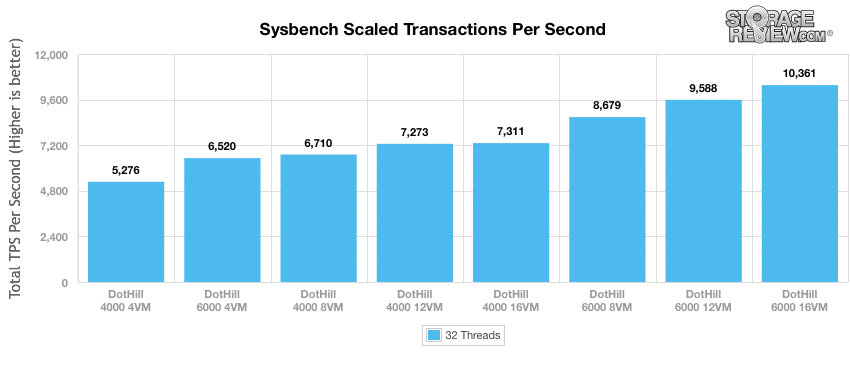
Looking at average aggregate latency in our Sysbench workload, at peak load the 6004 controllers maintained a response time of 49.4ms, whereas the 4004 controllers measured 70ms.
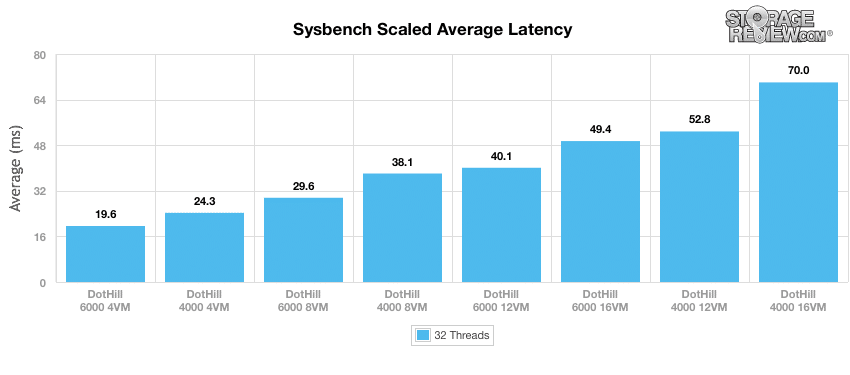
Peak latency as measured in our 99th percentile latency chart also showed strong gains with the faster controllers, keeping that average at 85ms, whereas the original controllers topped at 122ms.
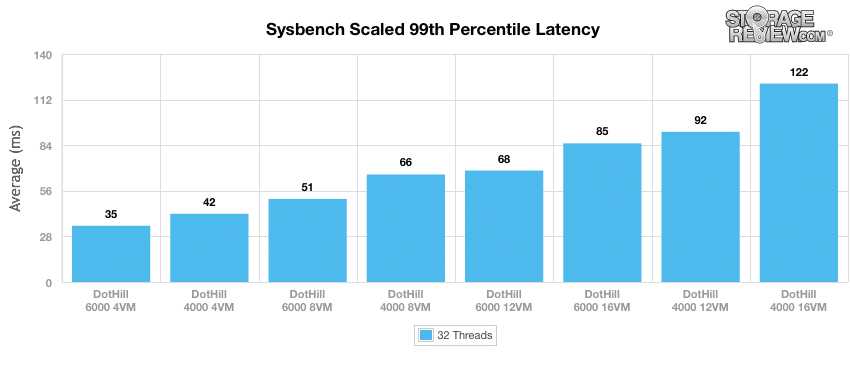
Conclusion
While changing nothing but the controllers in the Ultra48, Dot Hill clearly offers a lot of room to grow when looking at the 4004 and 6004 controllers. In this testing scenario where MySQL TPS is the core metric, we saw a 42% boost in performance at the top end. This compares to a 31% boost with the 12VM testing, which is really where the 4004s ran out of steam. If we were to apply more VMs, we would see this gap continue to widen and latencies spike on the 4004, while the 6004 marches on for a while more before hitting its limit.
Ultimately, Dot Hill has been able to continue to cram a vast feature set into their RealStor software, but clearly the hardware engineers keep busy too. As faster processors come out onto the market, dense platforms like the DotHill Ultra48 will continue to take advantage of newer and faster flash technologies. So for customers already satisfied by their Ultra48 purchase, and who enjoy the dense 48-disk configuration in a 2U chassis, one upgrade path exists to boost performance for an ever-growing I/O demand.



 Amazon
Amazon